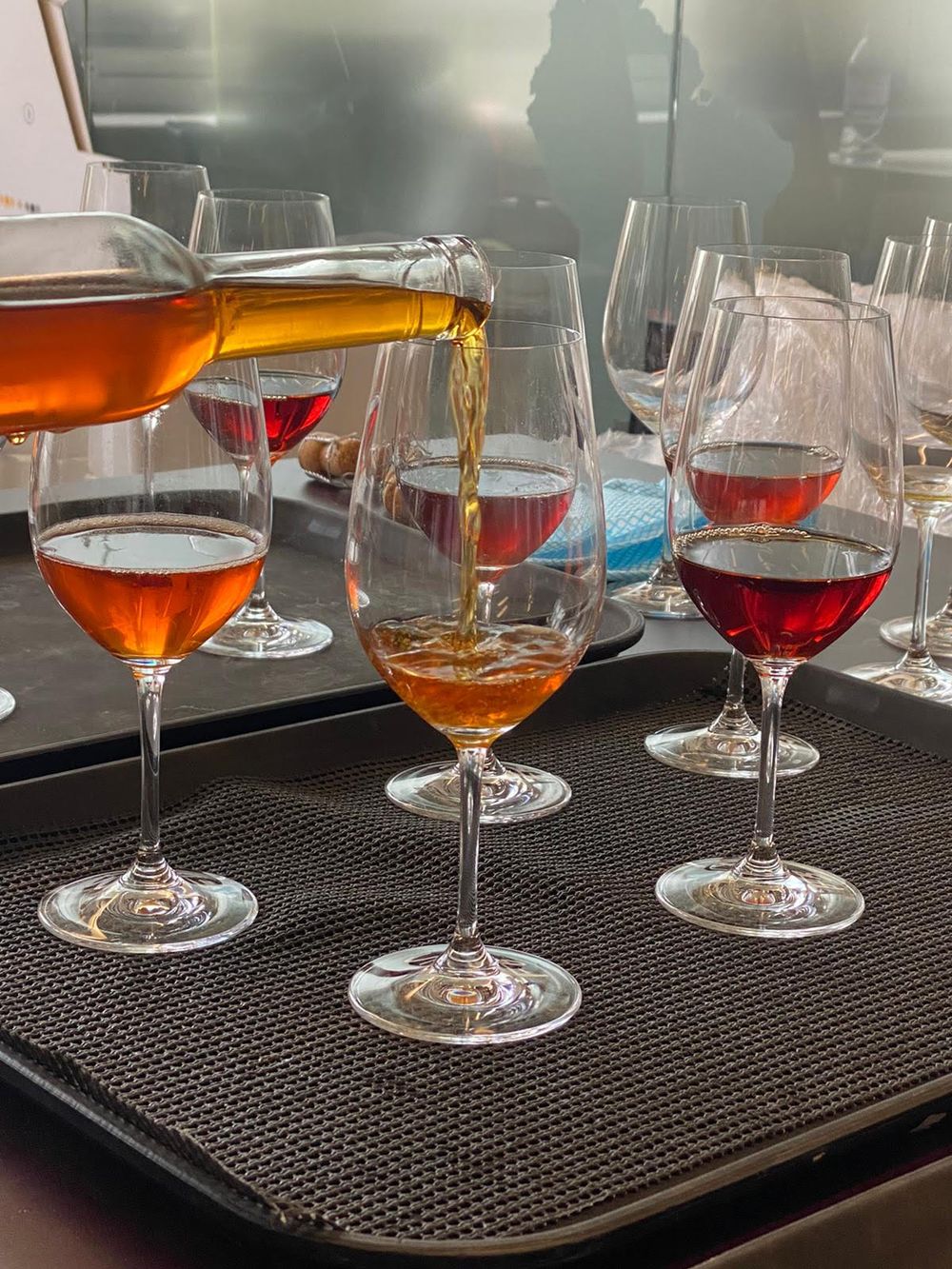With over 100 entries from 10 countries the IWSC’s first 100% fermented fruit tasting was able to shine the light on the quality products being made in this still largely misunderstood and overlooked category.
The IWSC’s key objective with its new 100% fermented fruit tasting and awards was to work with its partners, Cider Is Wine, to “highlight the quality and diversity of this under-explored category”. Such was the level of interest in the competition that the IWSC had to bring in more judges to cope with the number of entries it received.

Of the 100 plus products entered there were eight gold and 27 silver medals awarded. The Cider Trophy went to Welsh producer Llanblethian Orchards for its keeved cider, La Petite Grange du Cidre. The Ice Cider Trophy was awarded to Swedish producer Brännland Cider for its naturally-cold-produced ice cider, Brännland Iscider Barrique 2012.
Here the IWSC’s Christelle Juibert and Cider is Wine’s Alistair Morrell explain how the competition came together and what we should make of the results.
You have just held the first fermented fruit tasting as part of IWSC – can you explain what you mean by fermented fruit?
Alistair Morrell: The EU Wine law describes wine as “product obtained exclusively from the total or partial alcoholic fermentation of fresh grapes, whether or not crushed, or of grape must”. Cider Is Wine and the tasting takes a similar definition for the entrants. They are all produced and confirmed from 100% juice not-from-concentrate.
What sort of products fall into that category?
AM: Ciders, perries and fruit wines produced in many different ways. There are Traditional Method products – England invented this bottle fermentation over 10 years before Dom Perignon stepped into a winery in northern France. Then there are Keeved products – a process unique to cider production conducted mostly in Normandy and Brittany, historically in Western England, which grows pectin (Chapeau Brun in France) on the surface, which starves the juice of nutrients eventually stopping fermentation. The resultant cider or perry is deeper in colour, richer in fruit and dried fruit aromas and has more develop texture, flavours on the palate.
It also includes ice ciders made either by natural cold ageing or by other methods of freezing. There are only certain parts of the world that can achieve naturally cold ice ciders
Why did you decide to hold the tasting now and shine the focus on these products and this category?

The fermented juice tasting attracted entries from all over the world
Christelle Guibert: The IWSC is a trendsetter. We feel it’s a category with great potential and should be on everyone’s radar, especially sommeliers. Some of the more complex ciders are great alternatives to wine and are excellent with food. This tasting was an opportunity to shine the light on an under-explored and misunderstood category, and champion the artisanal producers making authentic drinks.
AM: Consumers are increasingly demanding their food and drink is authentic, provenance-led and has integrity. Whilst wine has clear EU legislation that supports it and has become the global standard. The cider, perry and fruit wine industries have few such high level quality standards. Global standards for production of this drink vary from 0% juice requirement to 100% depending on where you are, with producers often allowed to import concentrate as the ‘juice’ element. For example, in the UK a cider or perry can be made from 35% juice all of which can come from imported concentrate. So a British cider might not be all that it seems. The bar for fruit wines is even lower – generally 0%.
Consumers demand integrity and authenticity for food and drink, so featuring products which are 100% juice, not-from-concentrate is focusing on a type of product that fits the type of drink they would like to see. They want the real deal.
Furthermore the direction of travel of consumers is that of ‘less but better’. They want to drink less quantity and less alcohol. Typically these drinks are half the alcohol of a bottle of wine and are proud of their provenance and artisanship.
Ciders, by their nature are gluten free and over 95% of Cider Is Wine products are vegan or vegetarian.
What sort of producers entered and from what range of countries?
AM: Typically small artisan producers whose passion and individuality is often ‘writ’ large on their products. There were entrants from 10 countries and four continents.
How do you go about tasting and judging the products entered – in the same way you would a wine?
CG: We followed the IWSC judging standard, and the judges approach the tasting in the same way as they would approach wine tastings. Judges were rewarding the following qualities: harmony, texture, layers of complexity, finesse, nuance and surprises.
We presented the samples in smaller flight to keep the palate refreshed, and they were presented blind, pre-poured in Riedel glasses. We also limited the tasting to 55 samples per judge because of the sweetness and the high acidity.
Who was on the judging panel?

The line up of judges for the tasting
AM: A tasting is only as good as the judges and this tasting had an excellent array of knowledge, skills and experience on their panels. So our thanks very much goes to them. They include: Adam Wells a writer with an incredible in-depth view of his subject matter; Simon Day spans both wine and cider, the quiet innovator; Fiona Beckett widely known and highly respected in the wine, and food and drinks areas; Christine Parkinson, co-founder of Brimful Drinks and the expert on low & no; and Laure Patry the executive head sommelier at The Social company. I was honoured to be among their number.
Alistair you run the Cider in Wine organisation – can you explain what that is and what you hope to achieve?
Cider is Wine is the quality mark for ciders, perries and fruit wines fermented from 100% juice not-from-concentrate. Our vision is that by 2030 all appropriate trade and consumers globally will be aware of 100% juice ciders, perries and fruit wines.
We see education as our chief activity. We have to achieve glasses in hand, whilst educating the market about the different standards of product available.
As well as being a business with purpose we are a webshop and wholesale business. In the UK there is a £150m market available and Cider Is Wine sees itself as a leader in that sector.
It’s quite a coup for you and your members to be able to link up with IWSC in this way – what do you hope the tasting and judging and being involved in the awards can do for the category and its awareness, prominence and credibility?
AM: It is an honour for our members to be involved with the IWSC. Its 50 years of tasting and awards is testament to its durability and sustainability.
Christelle, as an appreciator of ciders, picked the opportunity early and with a $330 million market available, niche in global drinks terms, it represents a huge opportunity to bring a spotlight on the artisan skills, the passion of the producer and a whole new world of drinks exploration.
What do you think the perception of premium ciders and these sort of products are like in the trade?

The Michelin-starred L’Ortolan restaurant near Reading is a big supporter of premium ciders
AM: At best patchy. There are some pockets of real appreciation like with Marco Nardi at Laverstoke Park, Lucien Obreja of Michelin starred L’Ortolan, Coworth Park part of the Dorchester Collection, Grape Expectations in Marlow, The Whalley Wine Shop.
There are some supporters out there – Piotr Pietras the MS and former head sommelier at Hide, as well as his replacement, Dmytro Gonachuk, like ciders.
Some of the leading commentators and thought leaders have kindly identified Cider Is Wine as an organisation which invokes change. Oz Clarke, Olly Smith, Richard Bampfield MW, Christine Austin and Fiona Beckett have all made positive comments.
In general, however, most people in the trade are unaware of the cider quality boundaries – the 35% juice – they don’t know cider as a premium proposition. Cider Is Wine wants to change that.
Where they have been embraced they constantly surprise and delight customers and staff.
CG: Ania Smelskaya, a Brighton-based sommelier and consultant, is also a real cider advocate. She is known for her innovative wine lists and has been adding ciders to wine lists. She has worked and consulted for the likes of Sager + Wilde, Silo, Akoko and Osip. Unfortunately, she tested positive for Covid the night before the judging, and couldn’t make the tasting.
How many medals and trophies were handed out?
CG: We wanted to keep the tasting small as it was our first one of its kind, and our priority was to deliver a high standard tasting experience. However, we received more samples than expected, so more judges were recruited.
We tasted 109 samples and awarded eight gold and 27 silver medals. The judges re-tasted all the gold winners and awarded two trophies: an aged cider and an ice cider.
What do you see as the next steps to help build on this event and tasting and keep the momentum going?

The judges were asked to assess the products in the same way they would judge a wine
AM: We are still evaluating the tremendous response that we have had and are yet to form clear 2022 plans, apart from being certain we would like it to continue. The chatter and in depth discussions around the judges tables, told us just how much they appreciated these drinks and in some cases were a total revelation.
Will you have the fermented juice category in the 2022 awards. – and if so will you be looking to introduce new categories?
CG: Good question. The IWSC has always been innovative in their categories and judging, making the IWSC a pioneer. After all, it was the first official competition. The IWSC must continue to evolve and reflect the changing industry landscape to remain relevant to the consumer and trade.
There is an apparent demand for alternative drinks with lower alcohol, and we see it with our Ready to Drink and Low & No categories. We have teamed up with Christine Parkinson, and she has joined the IWSC judging committee as our Low & No expert. We are working with her in developing the alternative categories to the traditional wine & spirits, so watch the space.
Where do you see the next big opportunities for premium cider?
AM: The ice ciders, especially naturally cold produced, cannot pass without comment. They scored very highly in the IWSC tasting and had the largest number of entries for a category.
These are stunning examples of where ciders and fruit wines really punch well above their perceived weight. Typically with about twice the acidity of dessert wines, they achieve a balance that is sublime and pairs with food terrifically well.
- You can find out about the other categories and award winners in the IWSC by clicking here.
































